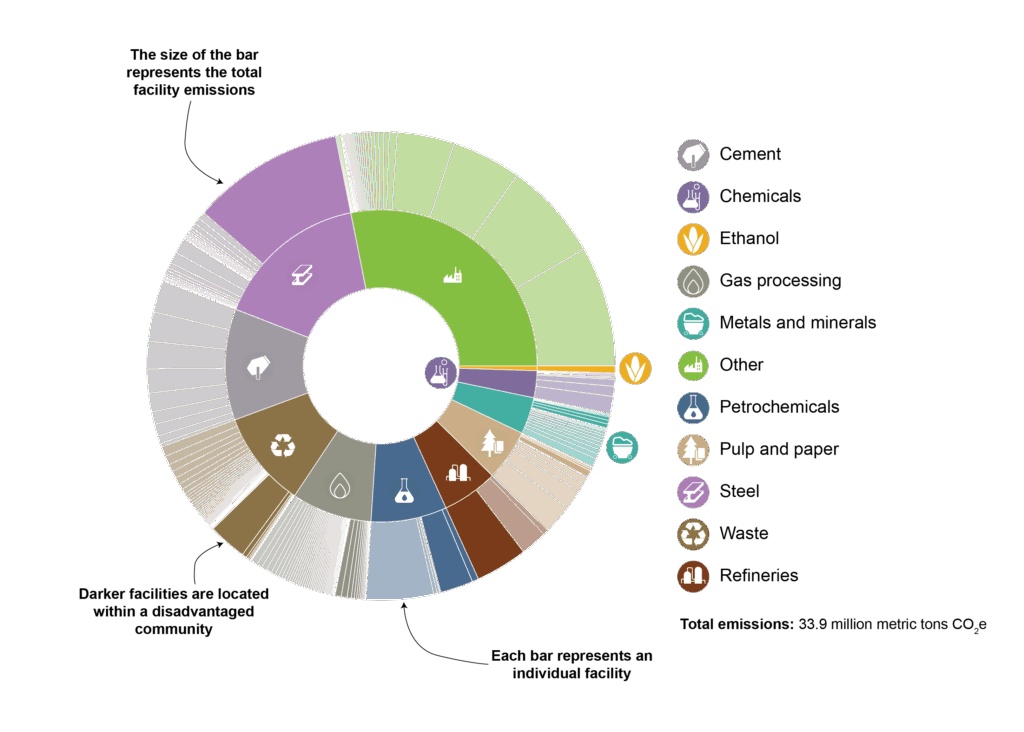Pennsylvania
Pennsylvania ranks seventh in industrial emissions. Its emissions profile reflects its long history of energy production. Underground coal mines and petroleum and natural gas systems are responsible for more than a third of industrial emissions. Production of metals (primarily steel making) and minerals (primarily cement and lime production) accounts for a third of emissions. Steelmaking and coal mining are rooted in Western Pennsylvania. North of Philadelphia, the Lehigh Valley is a center of cement and lime production.

- This map shows the top 20 emitters, coded by industrial sector. The size of the circles corresponds to emissions: the larger the circle, the higher the emissions.
- Disadvantaged communities (as determined by the federal government) are shaded blue.

- The inner circle provides a visual representation of the share of emissions generated by each industrial sector.
- The outer circle also indicates the share of a sector’s emissions generated in disadvantaged communities.
STATE ENERGY POLICY:
Examining a state’s broader energy policy landscape is helpful when considering policies to support industrial innovation. Pennsylvania has established executive greenhouse gas emissions targets and an alternative energy portfolio standard. Pennsylvania has not established a clean heat standard but committed in 2023 to exploring it. While these formal commitments are not prerequisites for innovative industrial policy, they can provide a supportive framework. In addition, streamlining permitting and establishing an efficient, transparent appeals process that engages local communities early while giving clarity and assurances to project developers are key components of effective state energy policy. Discussions around innovative industrial policy present an opportunity for broader conversations about state energy policy to ensure a mutually reinforcing strategy.
LEGISLATIVE context & opportunity:
Let us know if you are aware of additional legislation advancing industrial innovation in Pennsylvania that should be featured. The context below is not exhaustive and serves as an example of recent policies and programs and where there may be future opportunities:
- Reducing Industrial Sector Emissions in Pennsylvania (RISE PA): RISE PA is a $396 million statewide competitive grant program funded by the Environmental Protection Agency’s Climate Pollution Reduction Grants. RISE PA offers grants for small to large-scale industrial facilities to reduce emissions. The application for the medium- and large-scale track awards will be open through August 29, 2025.
- Appalachian Regional Clean Hydrogen Hub (ARCH2) and Mid-Atlantic Clean Hydrogen Hub (MACH2): Pennsylvania is part of ARCH2 with Ohio and West Virginia, as well as a part of MACH2 with Delaware and New Jersey. Pennsylvania is the only selected to partner with two regional clean hydrogen hubs. Independent of the outcome of the regional hubs, there is strong interest in building a clean hydrogen economy in this region to reduce emissions across hydrogen production, oil and gas development, and industrial manufacturing.
- Carbon management technologies are another opportunity to reduce industrial emissions in the state. Learn more about the economically feasible subsectors in Indiana and facilities that qualify for the federal 45Q tax credit. In 2023, Pennsylvania enacted S.B. 831, which established a legal and regulatory framework for carbon dioxide capture, utilization, and sequestration (CCUS) in Pennsylvania. CCUS will allow vital industries to remove carbon dioxide for use or storage. The framework is also a crucial element of ARCH2 located partially in Western Pennsylvania.
- A factsheet by the Renewable Thermal Collaborative identifies electrification of Pennsylvania’s steel, plastic recycling, and container glass subsectors as opportunities to reduce emissions significantly.
Explore recent legislation in Pennsylvania and all 50 states by clicking on a specific year: 2025 legislation, 2024 legislation, 2023 legislation.
